A worthwhile refinement on an industry-defining foldable that showcases the company's willingness to innovate on all fronts.
Should I Buy The Samsung Galaxy Z Fold 3?
Pros
- Improved design and durability
- Productivity powerhouse
- Beautiful displays
- Consistent cameras
Cons
- Some apps require manual optimisation
- Terrible under-display camera
- Cumbersome
Our Verdict
Price When Reviewed
- From $1,799.99
It may not have been the first but Samsung has managed to position itself as the category-defining brand when it comes to foldables; with its latest Galaxy Z Fold 3 likely to serve as the standard that similarly-styled rivals will be measured against (at least until the Fold 4 arrives).
The Z Fold 3 aims to meet expectations on three fronts: as a worthwhile refinement of the phone-to-tablet foldables that the company has produced so far, as a platform on which Samsung can test and implement its latest and greatest technologies, and as a representation of foldable innovation in general; serving as an indicator of how far the technology (and the associated costs) have matured, all in a relatively short time.
Design And Build
- Thick and heavy but well solidly built
- Water-resistance unheard of on foldables
- Dust accumulation around the hinge is a recurring issue
- Added grip when trying to unfold would have been useful
There was a brief moment where Samsung's foldable future nearly didn't make it out of the gate.
The original Galaxy Fold was a groundbreaking piece of consumer tech, to be sure, but it also suffered from some pretty significant engineering and build quality issues; most of which weren't much of a surprise to those with an appreciation for just how technically complex creating one of the first consumer-ready foldables must have been. In his review, Tech Advisor's then-Consumer Tech Editor, Henry Burrell described the phone as "an aspirational mess," which still feels apt, even with the hindsight of the Fold line's evolution.
Three years on and the anatomy of the original Fold persists in this fourth iteration, but it's littered with signs of the lessons Samsung has learnt along the way.
You're still getting a wedge-shaped, book-style, vertically folding form factor, dressed with an external cover display and an expansive internal screen, all housed in what Samsung has branded 'Armor Aluminium' (or 'Aluminum' to our Stateside readers). Durability is one of this generation's biggest upgrades, with a blend of polished and brushed aluminium alloy, surrounding the displays and spine of the phone's all-important hinge.
While the polished surfaces pick up smudges and smears, there's a pleasing confidence and precision in how the Z Fold 3 fits together and sits in the hand. It's both thinner (16mm at its thickest point when closed, versus 16.8mm) and lighter (271g versus 282g) than its predecessor, and Samsung has also performed what I assume is some sort of black magic (although more likely a mix of grease, rubber and CIPG) in order to render this Fold (alongside the Flip 3) the first water-resistant foldable(s) ever.
As impressive as this new trait is though, I do have concerns about the long-term validity of the phone's IPX8 certification, considering the moving parts at work; particularly when compared to more traditional 'static' candybar devices, like the company's own Galaxy S21. What's more, despite the dust caps (which were first added on the Fold 5G), the fear of fine dust, grit or powder working its way into the Fold 3's mechanisms still feels very real.
Speaking of unfolding, the hinge mechanism is reassuringly sturdy – instilling confidence with regards to long-term reliability – as well as being able to remain fixed at any point through its range of motion. Some knurling or texturing for added grip along the frame at the seam line would make opening up the Fold 3 significantly easier and far less precarious, though.
Provided you don't opt for the Thom Browne limited edition, colourways are more understated this year (compared to its predecessor); with Phantom Black, Phantom Silver or the signature colour – Phantom Green. There's also no option to customise the hinge of the Fold 3, as there was with the Fold 2, when bought directly from Samsung.
Display And S Pen
- Both panels support up to 120Hz
- Great overall brightness, colours and contrast
- Folding display's crease is only visible off-axis
- S Pen support is another impressive addition, even if functionality is limited
Using the Fold is a tale of two screens: the tall, narrow 6.2in 25:9 cover display on the outer face – which most closely portrays a traditional smartphone experience (even if it is oddly tall and thin) – and the titular 7.6in folding main display that, for the first few times you open and close the Fold 3, defies expectations as you watch pixels curve in on one another.
At the phone's launch, Samsung claimed that Fold owners use that cover display about as much as its main screen, so upgrading the refresh rate to a consistent 120Hz across both panels helps with the sense of seamlessness when transitioning between the two.
Perhaps one of the most important questions is "can you see or feel and the fold line running down the centre of the Fold 3's main display?" In a word, "yes", but it isn't a debilitating shortcoming as some might assume, so much as an inherent quirk of the current state of folding display technology.
In most situations, when viewed head-on, you cannot see the crease line at all; with colour and contrast only being thrown out of balance compared to the rest of the panel when viewed off-angle (more likely noticeable if you're watching something with a friend and you're both sat at an offset position). As such, the visual fidelity of the main screen feels comparable to that of Samsung's other 2021 flagship phones (albeit with a lower 374ppi pixel density – the 6.7in S21+'s Full HD+ display sports 394ppi) in most situations.
S Pen
As if sticking a folding screen on a phone wasn't enough of a challenge, Samsung has also upped the ante with the Z Fold 3's panel by adding its first ever under-display camera (more on that later) and implementing S Pen support too; making it the most versatile display on a consumer mobile device right now, by quite a margin.
While Samsung's signature stylus is an optional extra (and you need a special Fold Edition variant with a softer, sprung nib to use on the Fold 3's display), it makes for a strong pairing with the foldable's expanded canvas.
The S Pen Fold Edition still delivers a familiar stylus experience, with sensitivity comparable to touch input (even when drawing across the display's slightly dipped crease) and latency that feel's more than usable for the supported experiences.
If you're looking to jot notes down, scribble some quick doodles or get some digital illustration practice in, the S Pen is well-equipped for such tasks. For anything more serious, you might be better served by the likes of Apple's latest iPad Pro and Apple Pencil combination or a dedicated graphics tablet.
Although stylus input works in most apps, only a small handful capitalise on the S Pen's pressure and tilt recognition, limiting its full potential – something that Samsung has to work to improve across its various S Pen-capable phones and tablets.
Software And Features
- OneUI 3.1.1 helps make the most of the Fold's main display
- Google Play Store & Galaxy App Store
- Optimised for multitasking
- Some UI settings can be hard to find
- Some apps struggle to natively support the 4:3 aspect ratio
While running on Samsung's own take of Android 11 (with the promise of years of subsequent updates) from the outset, OneUI version 3.1.1 comes with optimisations specific to the Fold experience.
You'll still find a plethora of both Google and Samsung apps pre-loaded on the Fold 3 (with only light overlap), while extras from both sides of the fence (such as note and calculator apps) are available from their respective app stores; letting you pick and choose, as needed.
Beyond obvious inclusions, like one-handed mode and – when using the main display – an optional split keyboard for more convenient two-handed typing, Cover Screen Mirroring lets you choose whether your home screen layout remains consistent across both displays or whether you want independent layouts for the two discreet use cases they serve.
With the screen real-estate on offer from the main display, the Fold 3 can accommodate up to three apps at once (the best way to showcase its productivity prowess), with the ability to scale, resize and reorder chosen apps on the fly and even save them as a shortcut trio which you can reopen with a tap, whenever you like.
The only quirk is that, as Android still struggles as a tablet OS natively, Samsung's window management sits atop stock Android's rudimentary split-screen multitasking (which only supports two apps). It would have been cleaner and less convoluted if Samsung had simply hidden or disabled Android's own implementation; ensuring users only ever interacted with OneUI's optimised take on this (essential, in the case of the Fold) feature.
There are even options to force apps to adhere to certain aspect ratios – necessary for games like Call of Duty Mobile – which would otherwise fill the screen at an awkward resolution or with odd UI element placement. However, a few of the more powerful settings that wrangle unwieldy apps into submission like this remain tucked away in the Labs menu, which the average user might miss.
Performance
- Qualcomm Snapdragon 888 SoC + 12GB RAM
- 256GB or 512GB of storage
- Good real-world performance
Unlike the S21 range, there's no regional chipset split with the Fold 3, meaning wherever you pick one up, you're getting a device powered by Qualcomm's top-tier Snapdragon 888 SoC and 12GB of RAM (paired with either 256GB or 512GB of fast UFS 3.1 storage).
Even with more demanding hardware requirements – including that 120Hz refresh rate across both displays – compared to rivals, benchmarking places the Fold 3 in-step with equivalent devices, like the Huawei Mate X2 and other, more conventional, high-performance phones, such as Realme's GT and Samsung's own Galaxy S21.
Sure, it's not chart-topping – based on the numbers – but the real-world results only ever seemed to demonstrate flagship-class performance; with no obvious lag, crashes or heat build-up. Gaming is wholly enjoyable across both displays, even if some titles require a little optimisation during setup, in order to run as intended.
Perhaps what's most impressive is the continuity offered when switching from the cover display to the main screen. Even during video playback, the Fold 3 didn't skip a beat, with audio and video devoid of lag, despite the Fold technically having to re-scale the app on the fly as it moved from one aspect ratio and resolution to another.
Battery And Charging
- 4400mAh battery
- 25W wired charging, 11W wireless charging
- Longevity can vary wildly depending on which display you favour
With a body that resembles two phones welded together, there are actually two cells – one nestled on either side of the hinge mechanism – powering the Fold 3, adding up to 4400mAh in total (marginally smaller than the Fold 2's capacity).
Thankfully, you still have only one USB-C port to contend with – affixed to the right half of the Fold, when open – which supports Samsung's 25W fast charging, along with up to 11W wireless charging and 4.5W reverse wireless charging. Dubbed 'Wireless Power Share', this feature is ideal for topping up compatible true wireless headphones or the company's latest Galaxy Watch 4, for example.
As for longevity, beyond factors that affect all modern smartphones, like display technology (i.e. LCD or OLED), adaptive brightness and refresh rate – depending on how you use the Fold 3's two displays can have a huge impact on battery life.
If you're on the go, there's every chance you'll more readily favour the smaller cover display and likely use the phone less (as the narrow panel is less conducive to productivity), while days spent at home or at a desk may welcome more frequent two-handed use of the main display, resulting in faster battery drain as a result of the larger panel at work.
As such, in testing, I experienced strong variation, with one charge delivering 7.25 hours of screen-on time, while another only resulted in 4.25 hours.
For those looking to eek more hours out of their Fold – beyond resorting to the phone's battery saver settings – there are small tweaks that the Galaxy Fold community recommend to help extend the Fold 3's longevity (besides intentionally cautious use); such as enabling Dark Mode and disabling 'Nearby Device Scanning' in the Fold 3's connectivity settings.
Camera
- Triple rear 12Mp cameras
- 10Mp hole-punch cover display camera + 4Mp under-display camera
- Consistent image quality across rear sensors
- UDC is poorly implemented
Unlike the Huawei Mate X2 – which launched with the brand's best phone cameras to date – the Galaxy Fold 3 doesn't try to go all-out in the same fashion; instead offering up a trio of 12Mp rear sensors that capture imagery comparable to the likes of the S21, albeit with a smarter, optically stabilised 2x telephoto snapper in place of the S21/S21+'s 64Mp sensor.
Shots feature Samsung's signature colour vibrancy and more extreme contrast, compared to camera kings like Apple and Google, which at the flagship level, might be seen as a comparative lack of dynamic range, but images are consistent and usable to a degree that other high-end phones don't always match.
One could argue that a measly 2x magnification from the telephoto sensor raises questions about the value of its inclusion at all – particularly when, at its maximum 10x digital zoom, detail gets pretty dire – but the real offender here is the main display's front-facing snapper.
Under-Display Camera (UDC)
While the cover display also houses a (10Mp) front-facing camera, which takes decent selfies with nice colour reproduction (although perhaps with a touch too much oversharpening), Samsung decided that making a folding display with S Pen support wasn't challenging enough, deciding to use it as the stage on which they'd also debut their first under-display camera on a phone too.
While the technical feat itself is impressive, the general consensus is that it would have been better if Samsung hadn't bothered. The idea of an under-display camera is to hide the black cut-out that in-display cameras usually create behind a mesh of pixels, but the Fold 3's implementation has the opposite effect.
ZTE's Axon 30 5G already features second-generation under-display camera technology, hidden behind a grid of pixels the same density as the rest of the display; making it nearly imperceptible. By comparison, the resolution of the Fold 3's implementation is so low that you can actually pick out individual red, green and blue pixels with the naked eye.
There's also the fact, even with all of the post-processing that Samsung's imaging team clearly coded to try and clean the resultant images up the 4Mp sensor used is generally terrible, with narrow dynamic range, poor colour reproduction and bad low light support, especially when capturing video.
The silver lining in all this is Cover Screen Preview, which lets you snap selfies using the main rear camera while the Fold is open, showing a preview of the viewfinder on the cover display simultaneously. Even so, the under-display technology Samsung's used on the Fold 3 should have been kept within a lab until it was more mature and comparable to the competition before making its way onto a consumer-ready product.
Pricing And Availability
Samsung set the Galaxy Z Fold 3 on sale on 10 September, priced from £1,599/US$1,799/€1,799/₹149,999, which actually renders it more affordable than its predecessor – despite obvious improvements in areas like design and performance – likely in an effort, on Samsung's part, to further grow the appeal of the folding phone concept with consumers.
Even with a price cut over the Fold 2, this year's Fold still operates above the level of more conventional uber-flagships, like Samsung's Galaxy S21 Ultra, Xiaomi's Mi 11 Ultra and Apple's iPhone 13 Pro Max; meaning only those who don't want to swing for Huawei's even-pricier Mate X2 (or just want a current-gen foldable with Google Play Services) should apply.
If you like the space-saving aspect of the foldable form factor but want one that's even more compact, then the Galaxy Z Flip 3 – which launched alongside the Fold 3 – is worth considering. It benefits from an even more significant price cut over its predecessor and retains top-tier performance and water resistance, just like the Fold 3.
Pick up the Z Fold 3 from the likes of Samsung's website, retailers, including Amazon and carriers, such as Vodafone (suppliers of the device used in this review), who offer the phone up on their latest EVO plans, with trade-in of up to £504 on an accepted device, in the UK.
Verdict
There are a host of refinements that the Galaxy Z Fold 3 lords over its predecessor; with a cleaner, hardier design that somehow integrates water resistance, an expanded feature set (including S Pen support) and a lower starting price.
While processing, gaming and camera performance may not be industry-leading, the Samsung Galaxy Z Fold 3 focuses on making the foldable concept more attainable without presenting any real sacrifices in any particular area.
What the Fold 3 does highlight within this burgeoning product category, however, is that building experiences for folding form factors is hard and right now, Samsung is the principal driving force behind that getting any easier.
Specs
- 7.6in 22.5:18 QXGA+ (2208 x 1768) 120Hz Dynamic AMOLED 2X Infinity Flex Display
- 6.2in HD+ (2260 x 832) 120Hz Dynamic AMOLED 2X cover display
- Qualcomm Snapdragon 888 SoC
- 12GB DDR5 RAM
- 256GB or 512GB UFS 3.1 storage
- 12Mp f/1.8 main camera w/ OIS, Dual Pixel AF, 1.8µm pixels, 83° FoV
- 12Mp f/2.2 ultrawide camera w/ 1.22µm pixels, 123° FoV
- 12Mp f/2.4 telephoto camera w/ OIS + 2x optical zoom, 1µm pixels, 45° FoV
- 4Mp f/1.8 under-display camera w/ 2µm pixels, 80° FoV (main display)
- 10Mp f/2.2 hole punch selfie camera w/ 1.22µm pixels, 80° FoV (cover display)
- Android 11 w/ One UI 3.1.1
- Gorilla Glass Victus
- Side-mounted power key-cum-fingerprint sensor
- IPX8 water resistant
- Stereo speakers
- S-Pen stylus support (sold separately)
- Dual-SIM
- 5G
- WiFi 6E
- Bluetooth 5.2
- UWB
- NFC
- USB-C
- 4400mAh battery
- 25W wired charging
- 10W wireless charging
- 158.2 x 128.1 x 6.4 mm (unfolded), 158.2 x 67.1 x 16-14.4 mm (folded)
- 271 grams
- Colours: Black, silver, green





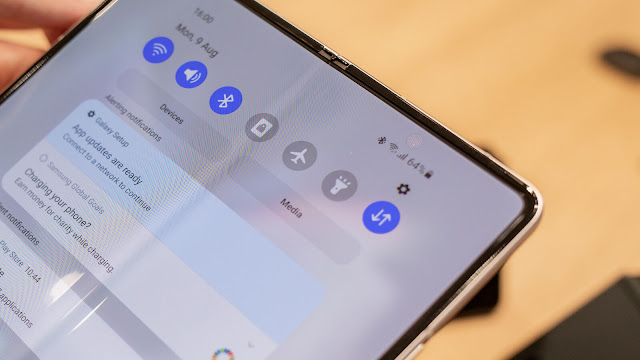
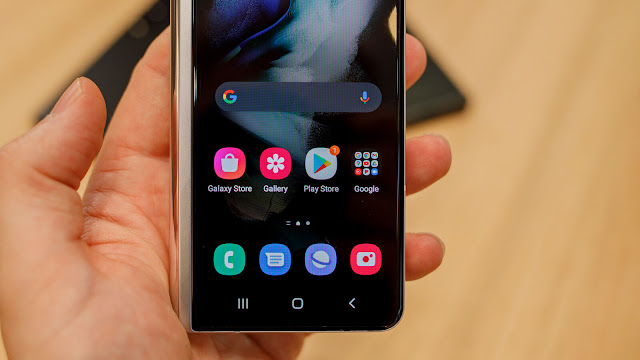
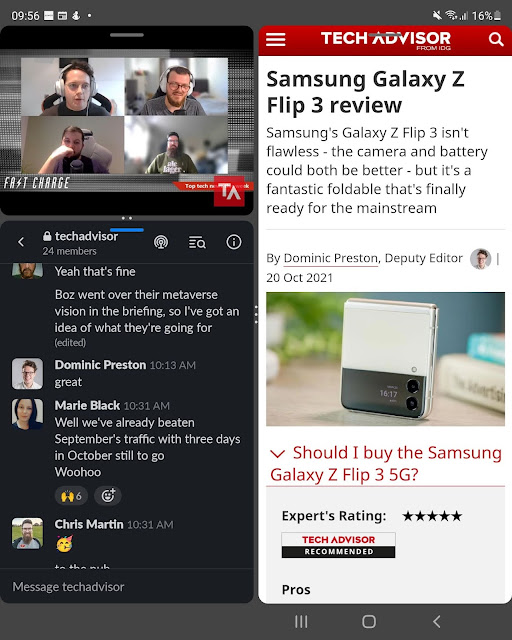






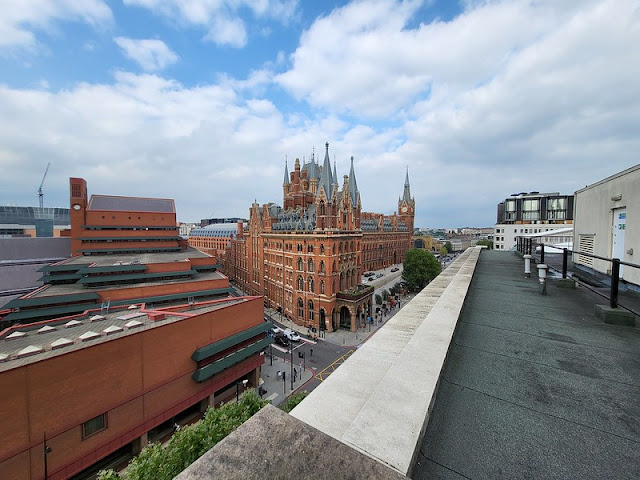









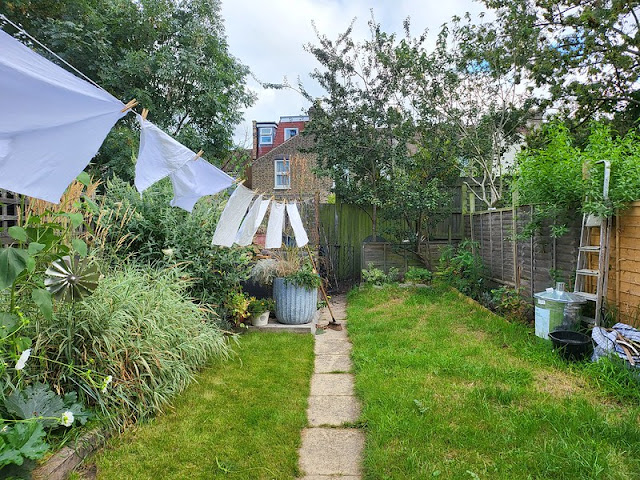









0 comments:
Post a Comment